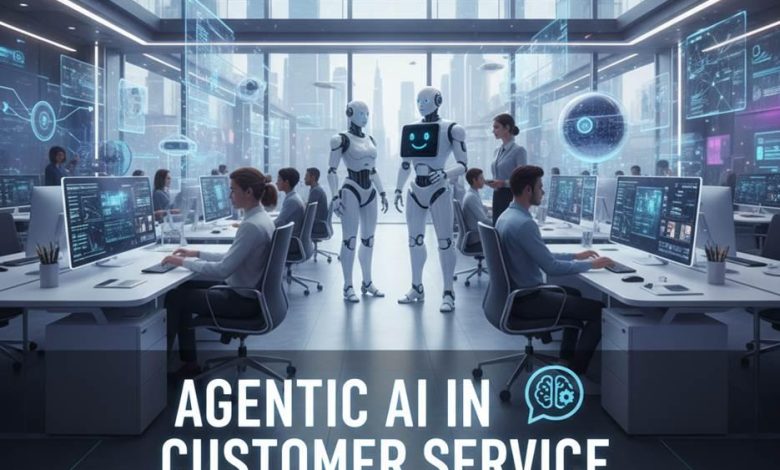
It’s 2025 & customer support is very different compared to a few years ago. Call centers are pressured to find solutions faster. They also have to grow, without making prices go through the roof, and keep service personnel enough that customers don’t drift away. The earliest indicated use cases acted like chatbots or simple automation: life got a little easier, but it was rare for the sort of tooling that took a task all the way to the finish.
Agentic AI is the embodiment of that evolution. So, what is agentic AI? It’s artificial intelligence that doesn’t just give you a list of answers, but actually thinks through a problem, decides what it should do, and does things on its own. In this guest post, we will explore how the AI Agent for Customer Service is changing user support & highlight the framework required for effective execution.
Understanding Agentic AI in Customer Service
In a marketplace that’s been transformed by the internet, where business is conducted at the speed of bits, companies can no longer get away and disconnected service models. Customers today want instant responses, one-on-one interactions, and consistent service across all channels. And that’s precisely what an Agentic AI-powered by AI Agent For Customer Service does, it behaves as a virtual employee and interacts with the customer, guiding, managing independently through the entire end-to-end journey.
Such as old-fashioned chatbots that are driven by set scripts or gun-toting AI assistants telling you what to do. Agentic AI uses sophisticated machine learning to understand context, anticipate intent, and process objects end-to-end automatically. But there’s more to Agentic AI than meets the ear. It needs a well-defined strategic approach that is aligned with company-wide objectives for it to be most effective.
Core Benefits Of Agentic AI in Customer Service
Customers are demanding more and more as time, accuracy, and customization become essential. An AI Agent for Customer Service answers those needs directly by being able to deal with customer-facing tasks on its own. Here are its standout benefits.
1. Operational Efficiency
Agentic AI for customer service enables operational efficiency by automating entire workflows, not just individual tasks, which results in taking the friction out of processes across the customer service flow. This ability to perform sophisticated actions with precision and without the need for extensive human guidance.
Also, help ensure organizations provide high-level service while pressured by streamlining resource allocation and speeding up response time, resulting in operational resiliency and scale. This effectiveness also helps save human agents’ time to concentrate on higher-level, more strategic plans.
2. End-to-End Process Ownership
Agentic AI’s biggest strength is its ability to autonomously manage entire customer service flows. Whereas humans-in-the-loop or task-specific AI assume away the problem of complaints, Agentic AI operates under the assumption that it takes complaints end-to-end – from understanding to taking ultimate action. It updates systems that need to be updated, like CRMs, without any human intervention, and routes the sorts of things that might involve us making decisions on which to prioritize against live data.
3. Improved user Engagement
AI-powered agentic customer service has pushed customer engagement to the next level with proactive support that feels natural and genuinely personalized. Rather than requiring customers to call for help, these systems analyze behavior and sense intent and step in proactively with useful interactions before problems occur. Moreover, the understanding acquired through these encounters can provide an in-depth knowledge of customer wants and reveal new service offerings or better products.
Real-World Applications Of Agentic AI in Customer Service
AI agents are redefining customer support by breaking human dependence with AI that is task-driven and oriented. The following four real-world use cases of Agentic AI in customer support span across the spectrum for industry-specific applications.
Fraud Resolution in Banking
Resolution of fraud in the traditional manner requires a number of different verifications and is time-consuming. Human fraud analysts require hours to analyze and report claims, resulting in them missing urgent cases that occur at scale.
Agentic AI changes this by automatically solving fraud cases in real-time on its own.
- Verify transaction history in real-time
- Cross-reference with fraud databases for patterns
- Automate refunds and compliance reporting
- Inform the customer what to do next
Autonomous Returns Processing in E-Commerce
In e-commerce, returns are a logistical mess: They often involve multiple steps and some human supervision. Agentic AI turns this on its head by managing the whole process itself.
When customers ask for a return, it interrogates them about the problem and checks purchase information, generates the return request, dispatches the logistics company to pick up what is returned, or informs a customer that they’ll have to ship it back, processes the refund, and updates inventory counts in warehouses, all without human hands.
Key Features of Agentic AI for Customer Service
Let’s look at the main features that you include in your Agentic AI for customer service.
- Scalability: Agentic AI scales from hundreds to millions of human-like interactions, allowing scalability for faster-growing companies.
- Decision-Making on Autopilot: Agentic AI senses context, mood, & history to resolve issues immediately and reduce wait times & increase user satisfaction.
- Actionable insights: It presents service trends & opportunities to proactively improve your services, so you stay ahead of customer needs.
- Continuous Self-Learning: Agentic AI learns at each interaction, applying new trends & insights to ensure your customer service strategy grows with your audience.
- Real-Time Adaptability: Agentic AI can change problem-solving modes, solving a problem before customers can ask for one.
Read More Articles:
Agentic AI vs AI Agents: How Do They Differ?
How Much Does It Cost to Build an AI Agent in 2025?
Multi-Agent AI Systems: Agentic AI Swarm Intelligence
Conclusion
Agentic AI for customer service represents a major change in the field of user support. This goes far beyond the automation of tasks; we are witnessing the rise of true autonomous digital workers that can run entire processes end-to-end. This is not just a small change, but despite reshaping of how businesses connect with their customers. It’s a journey of discovery, and we have to continue evolving, pivoting based on performance data, shifting when customer expectations change.




